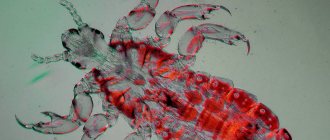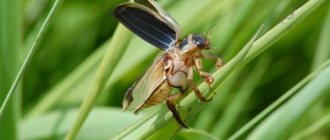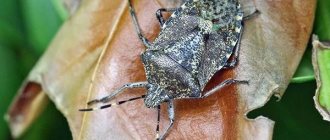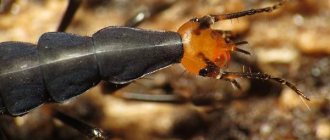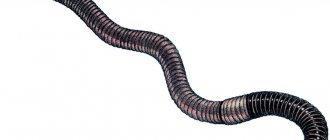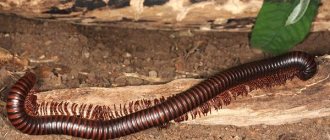Pliers: description
Such representatives of the arachnid species are not large in size, as they grow in length up to 3 mm and no more. The average size of these living creatures is in the range of 0.1-0.5 mm. Ticks, like all arachnids, lack wings. Adults have up to 4 pairs of legs, while juveniles have only 3 pairs of legs. Ticks also do not have eyes, but this feature does not prevent ticks from sensing their prey at a considerable distance, thanks to the presence of a special sensitive apparatus. Depending on the structure of the body, ticks are divided into several groups: leathery, with a head that is fused to the chest, and also with a head that is movably connected to the body (armored). Depending on this, each group breathes in its own way: the first 2 groups supply oxygen to their organs through the skin or trachea, and the last group breathes through a special organ.
Taiga tick / Ixodes persulcatus
Another representative of this most common type of tick usually lives in the forest zone, but can be found in meadows and thickets of small bushes.
They are carriers of encephalitis, but when bitten, bacteria that cause other dangerous diseases can enter the body of a person or animal. They wait for their prey in the grass or on a tree, not rising above one meter. Surprisingly, they do not have eyes, but they are perfectly oriented by the smells and warmth of people and animals. Ticks know very well where the paths that people often walk are located, so you need to be careful even when you are in places where people are often found.
In the last few years, the range of the taiga tick has expanded, and they can often be found in city parks, in suburban green areas and in summer cottages.
3
Diet of ticks
Depending on their diet, ticks are divided into:
- Saprophages that feed on organic matter.
Saprophages are involved in the process of converting humus, therefore they are considered very useful living beings. Parasitic mites, whose diet consists of plant sap, cause significant damage to agriculture. They destroy crop reserves at high speed.
Dust or scabies mites eat dead particles of human skin. Barn mites cause serious damage to food stored in warehouses. Subcutaneous mites eat fat that accumulates in human hair follicles. Spider mites suck the juices of various plants, including cultivated ones. Ear mites feed on the fat layer located in the ear canals.
- Predators that parasitize both animals and plants.
Blood-sucking ticks are constantly in their hiding places, where they wait for their potential victim. On the legs of these arachnids there are special claws and suction cups that allow them to cling to clothing, the body or skin of humans or animals. After they land on the body of their victim, they move to their places of vital activity. This could be the armpits, groin, head or neck area, etc. In this case, mites can parasitize the body of other types of mites or thrips.
Ticks, and especially their bites, are quite dangerous for humans, since parasites are carriers of fatal diseases such as encephalitis and others that are no less dangerous.
Ticks can remain without food for 3 years, but if they are very lucky, they become quite voracious, increasing in weight up to 120 times after being saturated with blood.
5 Most Dangerous Ticks in the World
What does a tick look like?
Ticks are currently represented by 50 thousand species. Of all of them, only 20% appear to be dangerous carriers of severe diseases. But even in this case, there are still not so few of them. Every fifth bite is caused by an infected individual.
What does an encephalitis tick look like? You can often hear the name - encephalitis tick. In fact, there is no such thing. An encephalitis tick is not a representative of the species, but an individual infected with a virus.
This could be any predatory individual. They feed on blood and parasitize warm-blooded creatures. And predatory representatives carry the virus with their saliva. In addition to encephalitis, ticks can also cause you to become infected with other diseases that are just as dangerous. The appearance of a tick with and without a pathogen is no different. You can only find out about the virus through a clinical analysis of the parasite. But most often the carriers of diseases are brown and taiga ticks.
A tick can parasitize a victim for a very long time. The male, after being completely saturated, falls off. But the female uses blood for her brood, so she can last much longer. It doesn't matter how long the tick has been sucking. He can simply bite and the poison has already entered, or he can suck without infecting it.
Types of ticks with photos and descriptions
Scientists know about more than 40 thousand species of ticks, which are divided into 2 main groups. For example:
- Parasitiforms, such as gamasid, argasid, nutallium and ixodid ticks.
- Acariformes, such as scabies, hair, feather, marine, freshwater, thyroglyphoid, acaridia, oribatiformes, sarcoptiformes and thrombidiformes.
- Haymaking ticks are also isolated as a separate group.
Main types of ticks and their description:
Ixodid ticks
They differ in that their body is covered with reliable chitinous plates. Moreover, they can have quite impressive sizes. There are species that reach a length of up to 2.5 cm. This type of tick prefers to parasitize in temperate latitudes, where they hide in the leaves of trees and shrubs. Therefore, they are found on almost the entire Eurasian continent. Potential victims of ixodid ticks are wild or domestic animals, as well as humans. If it gets on the skin of its victim, it will be able to feed on blood for several weeks. The female is quite fertile, as she is capable of laying up to 17 thousand eggs per season.
Argasid mites
They prefer to live in crevices of various buildings and outbuildings, and can also live in bird nests, which birds do not use. Their potential victims are poultry and animals, although they can also attack humans. They are often found in chicken coops. Argas mites bite quite painfully, and a profuse rash appears at the site of the bite and unbearable itching occurs. This parasite is characterized by soft skin, and the head protrudes slightly beyond the body and seems barely noticeable.
Armored mites
They are found on the soil surface, although there are species that live in trees. These ticks are not parasites, since they feed on natural food, in the form of mushrooms, lichens, living plants and their remains, and they also eat various carrion. Despite this, oribatid mites pose a certain danger to both birds and animals. The fact is that they can infect with various types of helminths, including tapeworms.
Gamasid mites
They settle in bird nests, chicken coops, and also in rodent burrows, since they parasitize on them. This parasite lives for a little more than 6 months, growing up to 1 mm in length. During this period of time, the parasite can cause serious damage to poultry farms. Their vital activity leads to significant loss of feathers in birds, as well as the appearance of extensive scratching on the skin.
Subcutaneous mites
They live under the skin of humans or animals, causing a lot of discomfort. However, if parasites are not properly controlled, they can live for years, causing severe itching and irritation. The female lives no more than 3 months, but during this period she lays an average of 100 eggs, from which viable individuals emerge in just a couple of days.
Scabies mites
These are parasites that can cause a difficult-to-treat disease called scabies. At the same time, ticks parasitize both humans and animals. The problem is that parasites make a lot of tiny passages in the skin of a person or animal, which leads to itching and redness. Ticks feed on skin secretions. Adult ticks live no more than one and a half months, but during this time the female manages to lay eggs several times.
Ear mites
They settle in the ears of cats and dogs. They pose no danger to humans, but cause a lot of trouble to animals. Animals scratch their ears vigorously, which often leads to severe inflammation.
Dust mites (bed, linen)
They do not parasitize the body of humans or animals because they feed on dust, fluff, feathers or dead particles of human epidermis.
They often cause a disease such as asthma, which is practically untreatable. The female lives up to 4 months and during this time lays about 3 and a half hundred eggs.
Spider mites
They do not parasitize humans, animals or birds, as they are “vegetarians”. Their main diet consists of plant sap. They can be found on the plant if you look under the underside of the leaves. In addition to the fact that they actively suck juices from plants, they can infect the plant with gray rot. This disease can lead to the death of the plant.
Water (sea) mites
For their life activities, they choose various bodies of fresh water. Some species prefer to live in salty sea water. As a rule, they parasitize mollusks and other insects living in the water column.
Predatory mites
They destroy their relatives, so people use this factor in the fight against parasites in greenhouses and greenhouse farms. Typically, predatory mites help control spider mites.
Barn mites
These are quite serious pests that cause great damage to grain or flour stocks, although they do not pose a danger to humans. Its vital activity leads to the unsuitability of food products, as they become clogged with waste from the vital activity of parasites. This leads to the appearance of mold and rot, after which it is unsafe to eat such products.
Pasture mites
They are found in the southern regions of Russia, Kazakhstan, Transcaucasia, etc. Prefers to live in forest or forest-steppe zones. They pose a danger to both animals and humans, since after their bites you can become infected with encephalitis, plague, fever, etc.
Brown dog ticks
They pose a great danger to dogs, although they are safe for humans. They are found almost everywhere, but especially numerous populations are found in coastal areas and on the Black Sea coast.
Top 5 most dangerous types of ticks for humans.
Gamasina mite
In the photo: on the left is an adult individual of one of the species of Vorroa gamasid mites; On the right is Varroa destructor on a bee pupa.
This infraorder of ticks contains more than 6 thousand parasitic species that pose a danger to animals and humans.
These are small animals about 1 mm long. In terms of the duration of their life cycle, these ticks live the shortest, up to 7 months. But they are common in wooded areas, and prefer closed areas, climbing into holes, cracks, and also live under the bark of trees.
But during such a short period of life, gamasid mites feed and lay eggs many times. They parasitize domestic animals and birds. They can also appear in poultry kept in an apartment.
They grow no more than 3 mm in length. Most common in small rodents, rats and mice. There are even corresponding subspecies - Rat and Mouse mites.
8
Where do ticks live?
Various types of ticks are found on almost all continents, regardless of climate zone. Ticks prefer damp areas of the landscape, so they are more often found in forest ravines, in undergrowth, in thickets of coastal vegetation, in flooded meadows, on overgrown paths, on animal fur, in dark warehouses, etc. Some species live in ponds, rivers, lakes and seas, and some species prefer human habitation and various outbuildings.
Ixodid ticks / Ixodida
The most dangerous family of ticks, numbering more than 650 species, belongs to the large order Ixodida. These small creatures are dangerous because they are carriers of diseases that are fatal to humans - tick-borne encephalitis and tick-borne borreliosis (Lyme disease).
These tiny animals live in all corners of our planet, and even in Antarctica they parasitize the bodies of penguins and birds. Adults grow up to 4 mm, and when filled with blood, reach a size of 10 mm. In Russia, ticks are found almost everywhere, except in arid places.
One clutch can contain up to 15 thousand eggs, but only a few survive during development. These dangerous creatures live from 2 to 3 years.
And now a little more about the representatives of the dangerous family of Ixodid ticks...
1
Mechanism of spread of ticks
On their own, ticks are not able to expand their living space, since they are able to overcome a few meters, but by attaching themselves to the body of a bird or animal, they are able to significantly expand their habitat. Ixodid ticks prefer to be in the temperate climate of Eurasia, but taiga and dog ticks are more common in Siberia, the Far East or the Baltic states.
Development (reproduction) cycle of ticks
Most species of ticks reproduce using eggs, although viviparous species are also found. All arachnids, including ticks, are characterized by division into the opposite sex. Blood-sucking parasites have the most interesting life cycle. In this case, the following stages of development are distinguished:
- Laying eggs.
- Appearance of larvae.
- Transformation into a nymph.
- Adult stage.
Grass mite / Dermacentor marginatus
A dangerous type of tick that can be found in the steppe zone is a carrier of tick-borne typhus and many other dangerous diseases, including encephalitis and Omsk fever.
Dermacentor marginatus parasitizes large domestic animals, as well as some inhabitants of the forest-steppe zone, such as hares or hedgehogs. The length of an adult reaches 4-5 mm, and when filled with blood up to 15 mm.
This species is dangerous because adult individuals often attack people, so it is necessary to carry out preventive measures to clear the areas around the home, and treat tents with special preparations.
And several more species of the most dangerous inhabitants of our planet...
6
Laying eggs
Somewhere towards the end of spring, with the arrival of summer, the female begins laying eggs. In this case, the number of eggs can reach up to 3 thousand, but before that the female must be saturated with blood. Tick eggs look quite voluminous compared to the size of the parasites themselves. Eggs consist of cytoplasm and a nucleus, which are covered with a reliable two-layer shell of various shades, depending on the species. Moreover, their shape can also be varied, both round and oval, both elongated and flattened.
How dangerous is a tick larva to humans?
After about 2-4 weeks, tick larvae emerge from the eggs, which have a direct resemblance to adult individuals. The only differences are their small size (only 0.5 mm) and the presence of 3 pairs of limbs, since adults have 4 pairs.
The body of parasites is not yet fully formed and some elements may be missing. The larvae appear in the warm season, so during this period they are most active. Since the larvae are still very small, they are not able to rise to a significant height. In this regard, their food items are rodents, hedgehogs, lizards, etc. Digging into the body of its victim, the larva consumes blood for 6 days, after which it falls off and ends up on the ground. The next stage of its development begins - the nymph stage. The larvae are not particularly affected by flooding and can remain under water for up to a month.
According to American scientists, the bite of a tick larva is as dangerous as the bite of an adult. This is especially true in relation to ticks, which carry dangerous diseases such as encephalitis.
Types of mites (intradermal, cutaneous)
The simplest division of mites is considered to be cutaneous and intradermal. They can also be permanent parasites or temporary. Permanent parasites live their entire development cycle on the animal, while non-permanent parasites (ixodid ticks) attack the dog only at a certain stage of their life. Skin mites are those mites that live on the skin of an animal. They do not penetrate the skin and their entire life cycle is on the surface. They can feed on epithelial scales, blood, and their eggs remain either on the dog or in the environment. These diseases include: otodectosis, cheyletiosis, ixodid ticks.
Otodectosis (permanent parasite)
. Microscopic mites that parasitize the ears. They feed on organic matter (skin scales). Waste substances are released into the ear canal. Otodectosis is rare in dogs, more common in cats. May be asymptomatic. Infection occurs regardless of the season.
Cheyletiosis (permanent parasite)
. A microscopic cutaneous mite that infects the skin of dogs. Most often located on the back of the animal. It may not bother you, but a large amount of dandruff appears (moving dandruff). Infection occurs throughout the year.
Ixodid ticks (temporary parasite)
. These ticks live in the environment and attack warm-blooded animals only in the adult (imago) stage, and the intermediate stage does not affect animals. They themselves are blood-sucking parasites, but they pose a greater danger because they are carriers of other serious diseases (pyroplasmosis, Lyme disease, bartonellosis). Most of all, dog owners are afraid of catching ixodid ticks in the summer.
Intradermal mites
dogs are also represented by several species. They damage the skin and live in its thickness, causing itching in the animal. These mites cause the following diseases in dogs: demodicosis, sarcoptic mange.
Sarcoptic mite
refers to itching and causes the disease sarcoptic mange (a permanent parasite). It infects the skin, making passages in it where it lays eggs. The disease is highly contagious and is transmitted through contact with a sick animal. Causes very severe itching; there may be no other symptoms.
Demodicosis (permanent parasite)
. This disease is caused by the intradermal demodex mite. It lives in hair follicles, where it reproduces. Causes very severe itching in dogs. Infection through contact with a sick animal.
Tick nymph and its danger
The nymph already has 4 pairs of legs, and its size reaches almost 2 mm. This parasite is already moving much more actively, so large animals or birds serve as food for it, and can also attack humans. What is most interesting is that the tick in the guise of a nymph overwinters and only with the onset of spring warmth it turns into sexually mature individuals of different sexes.
Nymphs, like adults, are capable of infecting humans with many serious diseases. Therefore, despite the fact that the tick individual has not yet formed properly, it is quite dangerous.
Scabies itch / Sarcoptes scabiei
Another intradermal parasite, which is popularly called simply “scabies mite.” This type of arthropod received this name because it causes scabies.
Once in the body of a person or animal, the itch begins to break through passages under the skin, feeding on blood. Moving around causes severe itching and redness. These mites are very small, and adults do not exceed 0.45 mm in size.
This parasite is dangerous not only because it causes severe scabies, but also because suppuration and inflammatory processes begin in areas of irritation.
10
Tick bite and diseases
The tick bite itself is a rather painful sensation, which is accompanied by negative emotions, itching, burning, and inflammatory processes. If only it all ended there! Together with saliva, the parasite is capable of transmitting some, sometimes fatal, ailments to its victim. For example:
- Lyme Borreliosis.
- Tick-borne encephalitis.
- Epilepsy and hyperkinesis.
- Arthritis.
- Jades.
- Problems with the gastrointestinal tract.
- Pneumonia or pulmonary hemorrhage.
- Heart arrhythmia and blood pressure problems.
- Paralysis of the limbs, with loss of capacity and ability to care for oneself.
Symptoms of a tick bite
As a result of a tick bite, a number of negative reactions of the human body are possible. This is especially true for people prone to allergies. For example:
- Inflammation of the bite site, which is accompanied by a significant increase in body temperature, fatigue and general weakness, chills, aches throughout the body, photophobia, swollen lymph nodes or Quincke's edema.
- In addition, severe headache, nausea and vomiting, and signs of hallucination with breathing problems are possible.
First aid for a tick bite
A tick bite is characterized by the fact that the parasite digs into the body of its victim. The first task is to get rid of the parasite, and you need to adhere to a number of rules. Firstly, the parasite cannot be crushed, and secondly, it must only be removed entirely. The head must not be allowed to remain in the human body. Before the extraction process itself, the problem area must be treated with hydrogen peroxide, iodine or another antiseptic. The steps are as follows:
- The protruding outer part of the parasite must be lubricated with vegetable oil and wait about 5 minutes. The respiratory organs are located in the tail part of the tick. When the parasite begins to suffocate, he will somehow begin to get out of this trap.
- The tick can be treated with kerosene and after 10 minutes it will either come off on its own or its grip will weaken. In this case, you can “unscrew” it using tweezers.
- If there is a wax candle nearby, then it is set on fire and the melted wax is directed towards the part of the parasite protruding from the human body. The wax will harden and cut off oxygen to it, which will force the tick to crawl out.
Mandatory step! The live tick should be stored in a plastic bag. After this, it should be taken to the laboratory for examination. The earlier the disease is detected, the easier it will be to cope with it.
In any case, after a tick bite, it is better to seek help from a specialist. In some cases, it is necessary to immediately call an ambulance. Otherwise, death is possible.
How to remove a tick with a thread If bitten by a tick How to Remove a tick with a THREAD Poddubnye
Subcutaneous mite
The most dangerous thing about this type of mite is that, as you can guess from the name, they can stay under human skin for a long time. But it’s scary that usually people don’t even know about its existence.
Only when the immune system is weakened, at the time of a cold or other infectious disease, does the tick begin to move deeper into the human body, causing pain, itching, redness and allergies.
Mostly ticks choose soft places, but the biggest problem for humans is when the parasites live under the skin of a person’s face.
9
Tick protection
Nowadays, modern industry has launched the production of many products - repellents that can protect humans and pets from tick attacks. At the same time, you can choose drugs for both adults and children. As a rule, the products are available in the form of sprays, which simplifies their use; just spray them on clothes. It should also be noted that there are some folk remedies that repel parasites. Due to their great sensitivity, parasites detect unpleasant odors at a distance of several meters. That's why:
- Ticks cannot tolerate the odors of many plants, including geraniums, marigolds and lavender. When going into nature, it is enough to put fragments of these plants in your pockets.
- Essential oils from the same plants have the same positive effect. To repel parasites, simply apply them lightly to your wrists and clothing.
- To protect yourself from the negative consequences of tick bites, it is better to go to a special institution and get vaccinated against tick-borne encephalitis. This disease is considered the most dangerous and most common.
Which ticks are dangerous to humans and pets?
What do ticks look like?
People, fearing for their own health and for the well-being of their animals, should have information about those parasites that carry a real risk of developing dangerous infections. There are conditionally 2 types of such mites - permanent and temporary parasites.
Constant parasites
These tiny arachnids, burrowing under the skin of warm-blooded animals and humans, live there constantly, that is, throughout their entire life cycle, causing undeniable harm through their own vital activity. Such diseases are usually called acariasis. As a rule, acariasis is caused by the following permanent parasites:
- ear mites affecting the outer ear and ear canal;
- scabies that affect the subcutaneous layers;
- demodicosis, when the face and the area around it are mainly affected.
Prevention consists of strict adherence to hygiene rules, especially where such ticks and their carriers live.
Temporary Parasites
Argasid and ixodid ticks
The only order that, during its own evolution, transformed into the form of temporary parasites is Ixodida. Only two families of this order - Argasidae and Ixodidae - pose a real threat with their bites to people and domestic animals, since they are able to climb onto the victim, pierce the skin, drink blood and thereby provoke a number of serious problems.
It is their accidental bites, possible during walks and trips into nature, that people rightly fear, wanting to avoid the following unpleasant and sometimes dangerous moments:
- infection of the bitten person with pathogens of dangerous diseases;
- itching and allergic reactions;
- dermatitis and other skin lesions.
After saturation, the process of which can last for a week in an adult female, and several hours in a male, the bloodsucker falls off on its own. If the parasite is not detected and removed in time, it will suck blood as much as it needs.
Interesting facts about ticks
- The smallest tick is known to reach a size of 0.08 mm. Because of this, this species is listed in the Guinness Book of Records.
- 3 adult specimens, each 0.2 mm in size, form a point commensurate with the size of a faintly noticeable point.
- The subfamily of ticks “Argasidae” has the ability of omovampirism, when hungry individuals attack their relatives who were able to get enough blood.
- The tick-borne encephalitis virus, like many other diseases, is transmitted transovarially. This means that an infected tick is able to lay already infected eggs, passing the disease on to future generations of ticks.
- Female ixodid ticks feed much more actively than males. As a result of complete saturation, the individual becomes 150 times larger than its hungry relatives.
- Ticks can lay completely unfertilized eggs, although completely viable larvae are subsequently born from them. This phenomenon is called parthenogenesis, which allows ticks to give birth to offspring without having sexual partners.
- Ticks can live up to 3 years without food, and such a hunger strike does not cause them any harm.
Otodectoid mites
There is only one species in the otodectoid genus - Otodectes cynotis. Parasitizes carnivores:
- dogs;
- cats;
- foxes;
- arctic foxes;
- ferrets;
- sables;
- fox dogs;
- trots;
- raccoon dogs;
- minks.
Parasites are capable of moving from one animal species to another. Particularly favorable conditions for infection with otodectosis exist on fur farms.
The causative agent of ear scabies has an almost transparent oval-shaped body and a whitish color. The length of the parasite is 0.3-0.7 mm. The mouthparts are piercing-sucking. It can only reproduce in the ear canals. The duration of the development cycle depends on the ambient temperature: in autumn and winter 18-22 days; in spring and summer 13-15 days. Without a host, this type of tick can survive up to 25 days at a temperature of 3-7°C and up to 14 days at -5-0°C.

